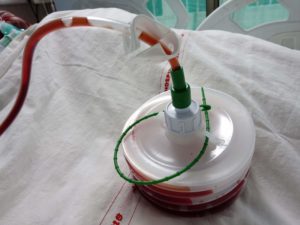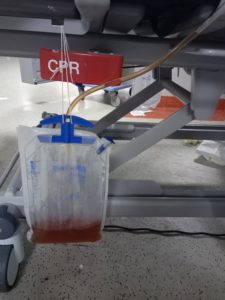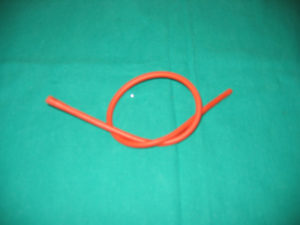Drains used to treat the accumulation of fluid such as pus, blood or serum. Different types of drains used in surgical practices. Drains used to evacuate air from the pleural cavity condition like
Pneumoperitoneum,
Emphysema etc.
Negative Pressure drain
Brand Name:
Portovac, Romovac, negative pressure drain.
Other names:
• Suction drainage apparatus
• Vacuum drain

Sterilization: Irradiation
Uses:
Suction drainage after certain operations as
- Thyroidectomy
- Cholecystectomy
- Splenectomy
- Biliary & urinary tracts operations
Advantages:
Closed system, creating negative pressure with no need for a suction machine.
It’s more effective and less liable.
It may cause infection than the corrugated rubber drain.
Corrugated rubber drains
Description:
Corrugated sheets of red rubber &/or plastic
Sterilization:
Boiling
Irradiation
Antiseptic solution
Uses:
Drainage of pus from abscesses
After certain operations like thyroidectomy, cholecystectomy, UT operations, appendicectomy
After laparotomy (for peritonitis) to prevent residual abscess in the postoperative period
Technique:
The drain applied at the site of operation, one small incision is made near to the surgical wound and brought out through a separate stab wound. The drain tube fixed to the skin by a surgical silk suture.
Care for drain: Daily dressing
Removal:
It’s removed after it stops draining from the surgical wound. The maximum duration of intact in wound site is about 3-5 days, 7 days after resection anastomosis.
- Infection to postoperative surgical wound
- Pressure necrosis caused by prolonged time.
- Bleeding from the exit wound.
- An incisional hernia if the drains, brought out through the primary incision.
- Loss of the drain inside the drained cavity.
- Corrugations create spaces, which help drainage.
- Insertion of a drain after thyroidectomy and modified radical mastectomy is mandatory.
- No drainage after appendicectomy except if it is complicated
and no drainage after herniorrhaphy except if it is strangulated.
Abdominal tube drainage
Description:
• Made up of silicon rubber or plastic
• It has a tube with multiple murphy eye holes for the drainage of residual fluids.
The end tube connected to collection bags containing a vacuum, this will form a closed system. It will reduce the possibility of infection tracking back into the tissues.
In this topic, the catheter is categories as
Malecot’s catheter
It made of the red rubber, with different diameter according to the indication. The end of the tube looks like a clover flower shaped with a wide diameter. The end of the tube placed inside the surgical wound and closed with the silk suture for the fixation, the bulbous tip and winged widely at the diameter.
Indication
For the drainage of the fluids and oozing at the surgical wound after closure.
Used as a feeding gastrostomy and jejunostomy tube.
Complication
High risk of tissue reaction.
It may cause infection to the surgical site.
Red rubber catheter
It is used in urology for temporary urine drainage and o guide the urethra at the time of urethroplasty and to lift the intestinal structure during surgery. The red rubber catheter avoided maximumly by most of the surgeon to reduce infection. It can’t use for the prolonged duration of time.
Complication.
It will cause more tissue reaction
